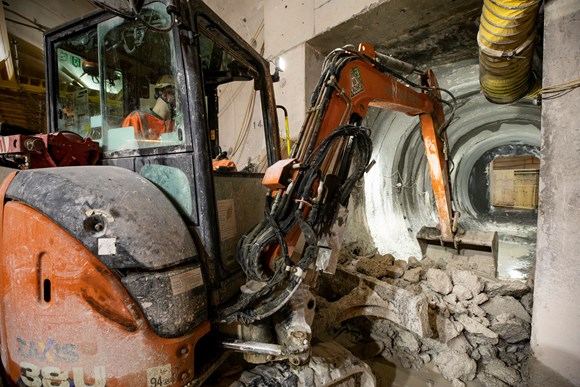The construction of HS2’s longest tunnels – stretching for 16km under the Chilterns – passed a key milestone this week with mining completed for 19 out of 38 emergency cross-passages linking the northbound and southbound tunnels.
Unlike the main running tunnels, which are being excavated using two Herrenknecht TBMs – named Florence and Cecilia – these smaller cross-passages are dug using remotely controlled mini-excavators.

An expert team of miners use the excavators to break out of the southbound running tunnel and dig the 15-20m to the adjacent northbound tunnel. As the excavation progresses the ground is supported using SCL.
Once the team has completed the SCL lined tunnel, a water-proof membrane is installed followed by a secondary concrete lining constructed by placing concrete behind formwork installed in the cross passage.
Aaron Harrison, HS2 Ltd’s Project Manager, said, “We’re making great progress on the Chiltern tunnel with approaching 9 out of 10 miles (14.5km – 16km) complete, and our cross-passage teams are catching up fast. Once complete, HS2 will dramatically improve journeys between London and the West Midlands, unlock tens of thousands of new homes and free up space on the busiest part of the West Coast Main Line.
“While invisible to the travelling public, these hidden passages have a key role in providing a safe operational railway so it’s great to see such good progress.”
The Chiltern tunnel is being delivered by HS2’s main works contractor, Align – a joint venture formed of Bouygues Travaux Publics, Sir Robert McAlpine, and VolkerFitzpatrick – which is also responsible for the nearby Colne Valley Viaduct, which also reached the halfway point last week.
Didier Jacques, Align’s Underground Construction Director, said, “I am delighted with the progress made by our cross-passage team, working in close cooperation with our supply chain partners. In particular I would like to acknowledge the contribution from KVJV who is responsible for the ground treatment, specialist contractor Euro Diamond Drilling and waterproofing specialist Renesco.”
Once the cross-passages are complete, they are temporarily sealed for fire safety reasons before permanent safety doors can be installed at either end. These are being manufactured by Bolton-based Booth Industries who won the contract to provide more than 300 units for all the tunnels between London and Birmingham.
The win allowed Booth Industries to establish a new facility in the town and create up to 50 jobs over the next 10 years. The sliding doors have been subjected to rigorous fire and fatigue testing to take account of the high train speeds, associated pressures and frequency of the trains.
Each running tunnel has an emergency walkway that allows passengers to safely evacuate the train and walk through the cross passages into the other tunnel where they can be rescued on a passenger train. Access for emergency services is from either the portal or one of the five ventilation/emergency access shafts. An additional 5 short tunnels known as ‘adits’, that connect the shafts to the running tunnels, are also under construction by the team with the mining on two of the adits already complete.
Florence and Cecilia are expected to breakthrough at the north portal early next year.
Comments: